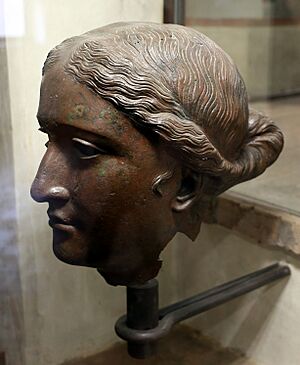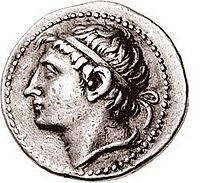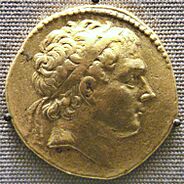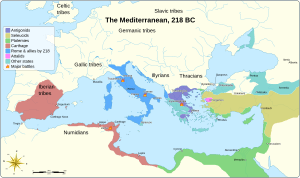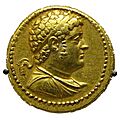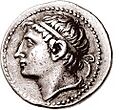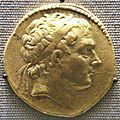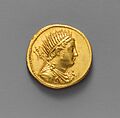Ptolemy IV Philopator facts for kids
Quick facts for kids Ptolemy IV Philopator |
|
|---|---|
| Greek: Πτολεμαῖος Φιλοπάτωρ Ancient Egyptian: Iwaennetjerwymenkhwy Setepptah Userkare Sekhemankhamun |
|
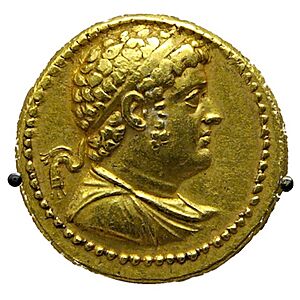
Gold octadrachm in the British Museum
|
|
| King of the Ptolemaic Kingdom | |
| Reign | 221 – 204 BC (Ptolemaic dynasty) |
| Predecessor | Ptolemy III |
| Successor | Ptolemy V |
| Consort | Arsinoe III, Agathoclea |
| Children | Ptolemy V |
| Father | Ptolemy III |
| Mother | Berenice II |
| Born | May or June 244 BC |
| Died | July or August 204 BC (aged 40) |
Ptolemy IV Philopator (meaning "Ptolemy, lover of his Father") was the fourth pharaoh of Ptolemaic Egypt. He ruled from 221 to 204 BC. Born in 244 BC, he became king at a young age.
His time as pharaoh saw a major war, the Fourth Syrian War, against the Seleucid empire. This war ended with a big victory for Egypt at the Battle of Raphia. However, later in his rule, parts of southern Egypt were lost to a rebel pharaoh. Ptolemy IV died in 204 BC, and his young son, Ptolemy V Epiphanes, became the next king. Some ancient writers said Ptolemy IV cared more about luxury than ruling.
Contents
Early Life and Becoming King
Ptolemy IV was the oldest son of Ptolemy III and Berenice II. He was born around 244 BC. His family was very important in the Ptolemaic Kingdom. His father, Ptolemy III, had made Egypt very powerful. They had won a big war against the Seleucid kingdom.
When Ptolemy III died in 222 BC, Ptolemy IV became king. He was about 20 years old. Two powerful advisors, Sosibius and Agathocles, had a lot of influence over him.
Changes in the Royal Family
When Ptolemy IV took the throne, Sosibius made sure that anyone who might challenge the new king was removed. Ptolemy IV's younger brother, Magas, died around this time. His mother, Berenice II, also died shortly after.
Ptolemy IV married his older sister, Arsinoe III, by 220 BC. Marrying a sibling was a common tradition for Egyptian royal families, including the Ptolemies.
Major Events During His Reign
The Fourth Syrian War (219–217 BC)
In 222 BC, Antiochus III became the new Seleucid king. He wanted to regain lands that the Seleucids had lost to Egypt. In 221 BC, he attacked Egyptian territories.
In 219 BC, Antiochus III attacked again. He captured the important port city of Seleucia Pieria. A Ptolemaic governor, Theodotus, even switched sides and joined Antiochus. This gave Antiochus control of Coele-Syria.
During this time, there was a small uprising in Alexandria. It was led by Cleomenes III of Sparta. He tried to start a revolt against Sosibius, but it failed. Cleomenes and his followers then took their own lives.
Antiochus III spent 219 BC securing his new lands. He agreed to a ceasefire with Ptolemy IV. Both sides used this time to prepare for more fighting. In 218 BC, Antiochus attacked again. He defeated Egyptian forces and captured more cities.
The Battle of Raphia
In 217 BC, Ptolemy IV and Arsinoe III led the Egyptian army to face Antiochus III. They met at Raphia on June 22, 217 BC. This was one of the biggest battles of the Hellenistic Age, with over 150,000 soldiers.
At first, the Egyptian war elephants were defeated. Antiochus charged forward and broke the Egyptian left side. However, Ptolemy IV appeared on the front lines. This encouraged his troops, and they fought back. The Seleucid army turned and fled. Antiochus III had to retreat.
After this big victory, Ptolemy IV reorganized his territories. He sent Sosibius to make a peace treaty with Antiochus III. Ptolemy IV kept most of his lands and received a large amount of gold. The victory was celebrated in Egypt with a special decree.
Later Foreign Relations (217–205 BC)
After the Fourth Syrian War, Ptolemy IV focused on keeping peace with other nations. He tried to rebuild Egypt's influence in Greece. He helped to end a war between Macedonia and the Aetolian League. He also gave money to several Greek cities.
Ptolemy IV kept good relations with Rome and Carthage. These two powers were fighting the Second Punic War. He received an embassy from Rome in 210 BC, asking for grain.
Egyptian Revolt and Ptolemy's Death (206–204 BC)
After the war, revolts started in Egypt itself. The reasons for these revolts are not fully clear. Some historians believe they were caused by the heavy taxes needed to pay for the war.
In 205 BC, a rebel leader named Horwennefer captured Thebes. He declared himself pharaoh. This revolt lasted for nearly 20 years. Because of this, Egyptian forces could not defend the southern part of the country from Nubian attacks.
Ptolemy IV died in July or August 204 BC. The exact reasons for his death are unclear. His wife, Arsinoe III, also died around this time. After a few days, his six-year-old son, Ptolemy V, was officially made king. Sosibius and Agathocles became his regents.
Ptolemaic Dynastic Cult

When Ptolemy IV became king, he was declared a god, called Theos Philopator (Father-loving God). He made the worship of the king and the royal family stronger. He linked it to the worship of Alexander the Great and Dionysus.
After the victory in the Fourth Syrian War, Ptolemy IV and Arsinoe III were formally added to the royal cult. This meant they were honored in special ceremonies. Ptolemy IV also had the tombs of Alexander the Great and earlier Ptolemaic kings moved. They were placed together in a new pyramid-shaped building in Alexandria.
Ptolemy IV also strongly promoted the worship of Dionysus. Dionysus was the Greek god of wine and luxury. Ptolemy IV wanted to be seen as a luxurious and powerful ruler. He started new festivals for Dionysus and even led some of the parades himself. He was sometimes called the Neos Dionysos (New Dionysus).

Many Greek cities under Ptolemy IV's control also created official cults to honor him. This was a way to thank him for his help and support.
Pharaonic Ideology and Egyptian Religion

Ptolemy IV also presented himself as a traditional Egyptian pharaoh. He supported Egyptian priests and built many temples. In 217 BC, after his victory at Raphia, he held a meeting of all Egyptian priests in Memphis.
This meeting resulted in the Raphia Decree. This decree was written in three languages: hieroglyphs, Demotic, and Greek. It celebrated Ptolemy IV's military success and his gifts to the priests. It showed Ptolemy IV as a hero, like the god Horus. In return, the priests agreed to put up statues of Ptolemy IV and Arsinoe III in their temples. They also started a five-day festival to honor them.
Ptolemy IV also continued building projects at temples across Egypt. The most famous example is the Temple of Horus at Edfu. Construction started under his father and continued through most of Ptolemy IV's reign. These temple carvings showed Ptolemy IV as an ideal pharaoh. They highlighted his victories and his respect for the gods.
Luxury and Grand Projects
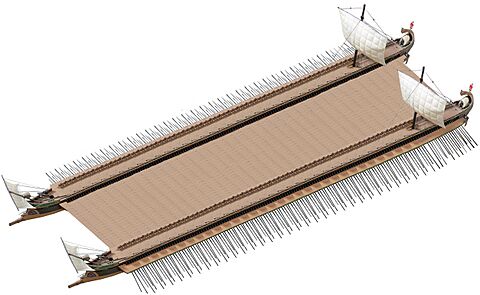
Ptolemy IV was known for his love of luxury. He built a temple for the famous Greek poet Homer in Alexandria. He also funded festivals for the Muses, who were goddesses of the arts.
He is also said to have built a giant ship called the tessarakonteres. This was a huge galley, possibly the largest human-powered ship ever built. It was described as being 128 meters long and needing 4,000 oarsmen. Experts believe it was a pleasure boat, not a warship.
Family Life
Ptolemy IV married his sister, Arsinoe III. Their only son, Ptolemy V, was born in 210 BC.
Images for kids


